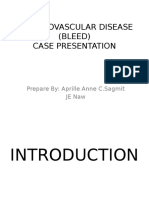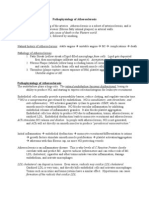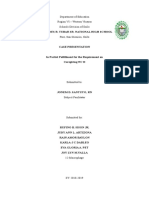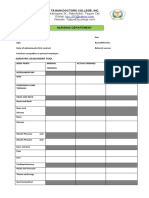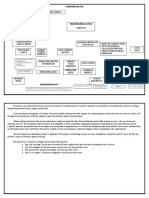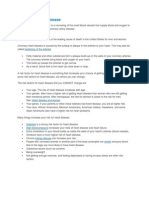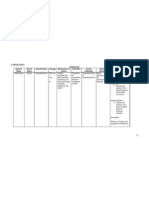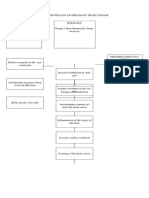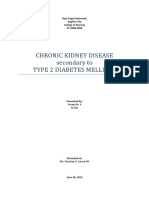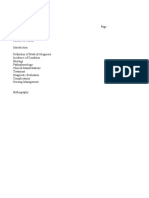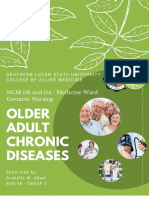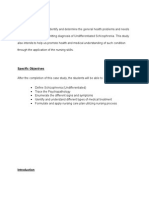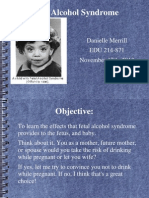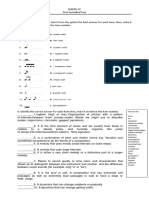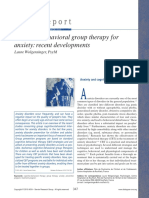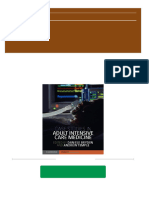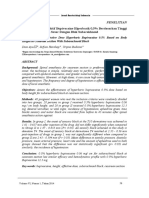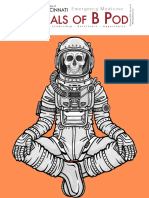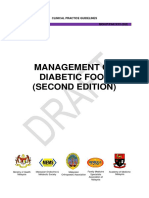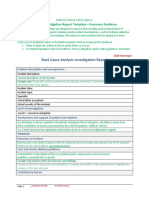0 ratings0% found this document useful (0 votes)
714 viewsPathophysiology
Pathophysiology
Uploaded by
Dimple BlancoThe document discusses the pathophysiology of stroke. It identifies predisposing factors like age, gender, family history, and precipitating factors like high blood pressure, diet, obesity, alcohol, and diabetes that increase the risk of stroke. It explains how these factors can lead to the formation of plaque in blood vessels, narrowing of the vessel lumen, turbulent blood flow, and atherosclerosis. This restriction of blood flow can cause ischemia, increased pressure, compression of brain tissue, and vessel rupture resulting in intracerebral hemorrhage. The signs and symptoms of stroke and treatments to control hypertension, decrease intracranial pressure, and rehabilitate are also outlined.
Copyright:
Attribution Non-Commercial (BY-NC)
Available Formats
Download as DOC, PDF, TXT or read online from Scribd
Pathophysiology
Pathophysiology
Uploaded by
Dimple Blanco0 ratings0% found this document useful (0 votes)
714 views3 pagesThe document discusses the pathophysiology of stroke. It identifies predisposing factors like age, gender, family history, and precipitating factors like high blood pressure, diet, obesity, alcohol, and diabetes that increase the risk of stroke. It explains how these factors can lead to the formation of plaque in blood vessels, narrowing of the vessel lumen, turbulent blood flow, and atherosclerosis. This restriction of blood flow can cause ischemia, increased pressure, compression of brain tissue, and vessel rupture resulting in intracerebral hemorrhage. The signs and symptoms of stroke and treatments to control hypertension, decrease intracranial pressure, and rehabilitate are also outlined.
Copyright
© Attribution Non-Commercial (BY-NC)
Available Formats
DOC, PDF, TXT or read online from Scribd
Share this document
Did you find this document useful?
Is this content inappropriate?
The document discusses the pathophysiology of stroke. It identifies predisposing factors like age, gender, family history, and precipitating factors like high blood pressure, diet, obesity, alcohol, and diabetes that increase the risk of stroke. It explains how these factors can lead to the formation of plaque in blood vessels, narrowing of the vessel lumen, turbulent blood flow, and atherosclerosis. This restriction of blood flow can cause ischemia, increased pressure, compression of brain tissue, and vessel rupture resulting in intracerebral hemorrhage. The signs and symptoms of stroke and treatments to control hypertension, decrease intracranial pressure, and rehabilitate are also outlined.
Copyright:
Attribution Non-Commercial (BY-NC)
Available Formats
Download as DOC, PDF, TXT or read online from Scribd
Download as doc, pdf, or txt
0 ratings0% found this document useful (0 votes)
714 views3 pagesPathophysiology
Pathophysiology
Uploaded by
Dimple BlancoThe document discusses the pathophysiology of stroke. It identifies predisposing factors like age, gender, family history, and precipitating factors like high blood pressure, diet, obesity, alcohol, and diabetes that increase the risk of stroke. It explains how these factors can lead to the formation of plaque in blood vessels, narrowing of the vessel lumen, turbulent blood flow, and atherosclerosis. This restriction of blood flow can cause ischemia, increased pressure, compression of brain tissue, and vessel rupture resulting in intracerebral hemorrhage. The signs and symptoms of stroke and treatments to control hypertension, decrease intracranial pressure, and rehabilitate are also outlined.
Copyright:
Attribution Non-Commercial (BY-NC)
Available Formats
Download as DOC, PDF, TXT or read online from Scribd
Download as doc, pdf, or txt
You are on page 1of 3
Pathophysiology
Predisposing factors Precipitating factors
Age, Gender, Family High Blood Pressure Diet, Obesity & alcohol
History
Susceptible for having extreme pressure ↑salt, ↑Na,
↑fats
diseases
increase risk for ↑BP dilatation of small vessels leads to formation of
plaque
vessels repair itself
↑ risk for TIA narrowing of vessel
(transient ischemic attack) thickening of vessels lumen
tortuosity of endothelium turbulent blood flow
formation of atherosclerosis plaque flow
↓ blood flow activation of clotting
cascade
ischemic infarct
increase pressure
compression of brain tissue
spasm of adjacent vessels
rupture of vessels
intracerebral hemmorhage in the brain parenchyma
Diabetes Mellitus Cigarrette Smoking
↑low density lipids & ↓ O2 concentration
↓high density lipids ↑ carbon monoxide in the blood
supply
Leads to constriction of vessels
Fomation of plaques
Increases blood pressure
Narrowing of vessels
Progression of macrovascular complication
blockage formation on vessels of the brain
ischemia on affected area
increasing pressure
compression of brain tissue
spasm of adjacent vessels
rupture of vessels
intracerebral hemmorhage in the brain parenchyma
Signs and symptoms
• Sudden Impaired speech
• Sudden Inability to see in one eye or double vision
• Sudden Inability to walk
• Sudden Paralysis on one side of the body
• Sudden Numbness or tingling
If treated: if untreated:
Diagnosis: increase intracranial pressure
computed tomography
MRI massive compression of tissues
Medication: progression of hemmorrage
anti-hypertensive
-to control hypertension decrease O2 supply in the brain
Diuretics
-to decrease icp death
antidiabetic agents
-to reduce effects of diabetes
Complication would be alleviated
Lifestyle changes
rehabilitation
You might also like
- Hamdard Catalogue PDFDocument75 pagesHamdard Catalogue PDFZeela Sherin0% (1)
- Cva NCPDocument1 pageCva NCPxiang jinNo ratings yet
- Barriers To Communication in Older AdultsDocument1 pageBarriers To Communication in Older AdultsLegendXNo ratings yet
- Doctor Name Practice Place Name SpecialtyDocument18 pagesDoctor Name Practice Place Name SpecialtySami Zaman MalikNo ratings yet
- Prescribing Regimens of Feeding JejunostomyDocument28 pagesPrescribing Regimens of Feeding JejunostomyRajarshi KumarNo ratings yet
- Outline Prog NoteDocument3 pagesOutline Prog NoteSetya Gon FreccssNo ratings yet
- Case Presentation On Antepartum Hypertention IDocument18 pagesCase Presentation On Antepartum Hypertention IJoule PeirreNo ratings yet
- 19 - Fibromyalgia 5 Causes 5 Ways To ImproveDocument48 pages19 - Fibromyalgia 5 Causes 5 Ways To ImproveFrida Bendersky100% (3)
- Skinfold Measurements - FemaleDocument2 pagesSkinfold Measurements - Femaleapi-368093620No ratings yet
- Ventricular Septal Defect, A Simple Guide To The Condition, Treatment And Related ConditionsFrom EverandVentricular Septal Defect, A Simple Guide To The Condition, Treatment And Related ConditionsNo ratings yet
- Cerebrovascular Disease (Bleed)Document25 pagesCerebrovascular Disease (Bleed)Margaret Jenaw JenawNo ratings yet
- Risk NCP Decreased Cardiac OutputDocument2 pagesRisk NCP Decreased Cardiac OutputMICHELLE FACTONo ratings yet
- DB13 - Pathophysiology of AtherosclerosisDocument2 pagesDB13 - Pathophysiology of Atherosclerosisi_vhie03No ratings yet
- GRP 20 Final Abscess Case StudyDocument14 pagesGRP 20 Final Abscess Case StudyBorja, Kimberly GraceNo ratings yet
- Case Presentation DocumentsDocument10 pagesCase Presentation DocumentsMary Therese Joy BaldozaNo ratings yet
- Case Pres A1-RhdDocument11 pagesCase Pres A1-RhdCharm TanyaNo ratings yet
- DRUG STUDY (Lung Cancer)Document10 pagesDRUG STUDY (Lung Cancer)Jobelle AcenaNo ratings yet
- Tagum Doctors College, Inc.: Mahogany ST., Rabesubd., Tagum City E-MailDocument4 pagesTagum Doctors College, Inc.: Mahogany ST., Rabesubd., Tagum City E-MailRoel John Atamosa CasilacNo ratings yet
- Placenta Previa PathoDocument2 pagesPlacenta Previa Pathoshakira0% (1)
- Obstructive Uropathy Secondary To Benign Prostatic HyperplasiaDocument74 pagesObstructive Uropathy Secondary To Benign Prostatic HyperplasiaGregory Litang100% (1)
- PPPDocument3 pagesPPPJack BangcoyoNo ratings yet
- CASE PRESentationDocument30 pagesCASE PRESentationllanelli.graciaNo ratings yet
- CHOLECYSTECTOMYDocument3 pagesCHOLECYSTECTOMYlovelysummerNo ratings yet
- Hepatic Encephalopathy: PRESENTER:Dr - Ch.Priyanka (DNB Junior Resident) Moderator: DR - Thirupathi Reddy (AssociateDocument19 pagesHepatic Encephalopathy: PRESENTER:Dr - Ch.Priyanka (DNB Junior Resident) Moderator: DR - Thirupathi Reddy (AssociatePriyanka ChinthapalliNo ratings yet
- ESRD PathophysiologyDocument2 pagesESRD Pathophysiologynursing concept mapsNo ratings yet
- Anemia Pathophysiology All in 1 by Francis OliverosDocument3 pagesAnemia Pathophysiology All in 1 by Francis Oliverosfrancis00090No ratings yet
- CHD With NCPDocument10 pagesCHD With NCPJohanna Kirsten F. DaguioNo ratings yet
- Rheumatic Heart Disease - Patho - DiagramDocument10 pagesRheumatic Heart Disease - Patho - DiagramJoann100% (12)
- Drug StudyDocument9 pagesDrug Studylorraine_22No ratings yet
- PathophysiologyDocument9 pagesPathophysiologySuzette PipoNo ratings yet
- RHD PathophysiologyDocument3 pagesRHD PathophysiologyRichmond LacadenNo ratings yet
- NCP Impaired Physical MobilityDocument9 pagesNCP Impaired Physical MobilityChristian Apelo SerquillosNo ratings yet
- HCVDDocument5 pagesHCVDkhrizaleehNo ratings yet
- Minggu 5 LP THALASSEMIADocument14 pagesMinggu 5 LP THALASSEMIAMuhammad PanduNo ratings yet
- Chronic Kidney Disease Secondary To Type 2 Diabetes MellitusDocument84 pagesChronic Kidney Disease Secondary To Type 2 Diabetes Mellituswar5No ratings yet
- A Drug Study On FansidarDocument7 pagesA Drug Study On FansidarCasey EmellanoNo ratings yet
- Stroke PathoDocument15 pagesStroke PathoWiljohn de la CruzNo ratings yet
- Cva Case StudyDocument31 pagesCva Case StudyZoe AnnaNo ratings yet
- TPN NCPDocument10 pagesTPN NCPArabylle Maranca AbuelNo ratings yet
- Case Study COPDDocument2 pagesCase Study COPDNicole SimoneNo ratings yet
- 1 - Perception and CoordinationDocument37 pages1 - Perception and CoordinationJek Dela CruzNo ratings yet
- Schematic Diagram Pathophysiology (Book-Based) COPD and TuberculosisDocument1 pageSchematic Diagram Pathophysiology (Book-Based) COPD and Tuberculosispragna novaNo ratings yet
- Kardex: Diet: Interventions IVF (Indicate Date and Time Started) Room Number: 313Document2 pagesKardex: Diet: Interventions IVF (Indicate Date and Time Started) Room Number: 313kuro hanabusaNo ratings yet
- Lupus Case ReportDocument1 pageLupus Case ReportMendy HararyNo ratings yet
- Anatomy and Phsyiology of MeningococcemiaDocument2 pagesAnatomy and Phsyiology of MeningococcemiaKevin Comahig100% (1)
- Bone Fracture Concept MapDocument1 pageBone Fracture Concept MapJette Charmae OlboNo ratings yet
- Blood Dyscrasia SDocument24 pagesBlood Dyscrasia SMasha FloreaNo ratings yet
- Cva PathophysiologyDocument2 pagesCva PathophysiologyMaryjoy MertallaNo ratings yet
- How Stroke Affects Speech and LanguageDocument5 pagesHow Stroke Affects Speech and Languagemino songNo ratings yet
- NCP Risk For Infection Related To Postop IncisionDocument1 pageNCP Risk For Infection Related To Postop IncisionCharry de VeraNo ratings yet
- Pathophysiology of Hypertension in Chronic Kidney DiseaseDocument7 pagesPathophysiology of Hypertension in Chronic Kidney DiseaseRifka WidianingrumNo ratings yet
- ThalassemiaDocument1 pageThalassemiaJobelle Fernandez-SantosNo ratings yet
- Case Presentation (Final)Document35 pagesCase Presentation (Final)Denie BoyonasNo ratings yet
- NCP IcuDocument2 pagesNCP IcuDiana MuañaNo ratings yet
- Transient Ischemic AttackDocument3 pagesTransient Ischemic AttackJevisco Lau100% (1)
- Case Study: Breast CancerDocument72 pagesCase Study: Breast CancerJoy Mariel Isadora BurgosNo ratings yet
- Open I Tibia Fibula (R) Lacerated Wounded Leg: Our Lady of Fatima UniversityDocument21 pagesOpen I Tibia Fibula (R) Lacerated Wounded Leg: Our Lady of Fatima UniversityPOTENCIANA MAROMANo ratings yet
- Cns Case PresentationDocument33 pagesCns Case Presentationapi-542965039No ratings yet
- Rle Module Rle Unit Week: Bachelor of Science in Nursing: Rle NCM 105 - Psychiatric NursingDocument6 pagesRle Module Rle Unit Week: Bachelor of Science in Nursing: Rle NCM 105 - Psychiatric NursingAllisson BeckersNo ratings yet
- Exercise No.009Document2 pagesExercise No.009bea pegadNo ratings yet
- Pathophy - Nephrotic SyndromeedDocument1 pagePathophy - Nephrotic Syndromeedianecunar100% (1)
- CASE STUDY PheumoniaDocument5 pagesCASE STUDY PheumoniaEdelweiss Marie CayetanoNo ratings yet
- Cefoxitin and Ketorolac Edited!!Document3 pagesCefoxitin and Ketorolac Edited!!Bryan Cruz VisarraNo ratings yet
- Case AnalysisDocument12 pagesCase AnalysisFroilan TaracatacNo ratings yet
- A Simple Guide to Parathyroid Adenoma, Diagnosis, Treatment and Related ConditionsFrom EverandA Simple Guide to Parathyroid Adenoma, Diagnosis, Treatment and Related ConditionsNo ratings yet
- A Simple Guide to Pseudohypoparathyroidism, Diagnosis, Treatment and Related ConditionsFrom EverandA Simple Guide to Pseudohypoparathyroidism, Diagnosis, Treatment and Related ConditionsNo ratings yet
- Sta. Ana Hospital: Covid-19 Testing LaboratoryDocument1 pageSta. Ana Hospital: Covid-19 Testing LaboratoryNestor Limos Alfaro Jr.No ratings yet
- WalshcDocument26 pagesWalshcapi-530445129No ratings yet
- Thermal BurnsDocument50 pagesThermal BurnsPooya WindyNo ratings yet
- Senior Citizen Survey Form (Long)Document3 pagesSenior Citizen Survey Form (Long)Kenoy100% (1)
- Answers, Rationales, and Test Taking Strategies: Managing Care Quality and SafetyDocument14 pagesAnswers, Rationales, and Test Taking Strategies: Managing Care Quality and SafetyNursyNurseNo ratings yet
- Fetal Alcohol SyndromeDocument16 pagesFetal Alcohol Syndromexdaniellecutiex100% (1)
- cc11046 PDFDocument189 pagescc11046 PDFNurfadhilah YusufNo ratings yet
- MAPEH 10 - First Periodical TestDocument3 pagesMAPEH 10 - First Periodical TestTeacherbhing MitrcNo ratings yet
- Wolgensinger, 2015 PDFDocument5 pagesWolgensinger, 2015 PDFPau liNo ratings yet
- Ebooks File Case Studies in Adult Intensive Care Medicine 1st Edition Daniele Bryden All ChaptersDocument49 pagesEbooks File Case Studies in Adult Intensive Care Medicine 1st Edition Daniele Bryden All Chapterssefridimoutt8100% (4)
- Eliezer V. Gellido EZER'Document105 pagesEliezer V. Gellido EZER'honeykrizelNo ratings yet
- Sri Wulandari N., M.Kep., Ns - Sp.Kep - AnDocument11 pagesSri Wulandari N., M.Kep., Ns - Sp.Kep - Anefi afriantiNo ratings yet
- Penentuan Dosis Efektif Bupivacaine Hiperbarik 0,5% Berdasarkan Tinggi Badan Untuk Bedah Sesar Dengan Blok SubarakhnoidDocument9 pagesPenentuan Dosis Efektif Bupivacaine Hiperbarik 0,5% Berdasarkan Tinggi Badan Untuk Bedah Sesar Dengan Blok SubarakhnoidChrist YanuarNo ratings yet
- Winter+AoBP+2 2+SMDocument16 pagesWinter+AoBP+2 2+SMJuan Carlos LopezNo ratings yet
- Special Article: ResumenDocument7 pagesSpecial Article: Resumentomas arturo tejeda rodalNo ratings yet
- Lab Report NewDocument2 pagesLab Report Newnsdh5v5v5sNo ratings yet
- Draft CPG Diabetic FootDocument52 pagesDraft CPG Diabetic FoothudaNo ratings yet
- Comprehensive Case Study On Pulmonary Embolism: Prepared byDocument17 pagesComprehensive Case Study On Pulmonary Embolism: Prepared byKristopher John Jimenez100% (1)
- Application of AgNORDocument5 pagesApplication of AgNORManar AliNo ratings yet
- Plague DISEASEDocument14 pagesPlague DISEASETaif AlhashimNo ratings yet
- Root Cause Analysis Template 20Document3 pagesRoot Cause Analysis Template 20vinodkumar raju chamarthiNo ratings yet
- Acute Treatment of Hypocalcaemia (Adults)Document2 pagesAcute Treatment of Hypocalcaemia (Adults)Ahed WarwarNo ratings yet
- Update in NephrologyDocument6 pagesUpdate in NephrologyScivision PublishersNo ratings yet










